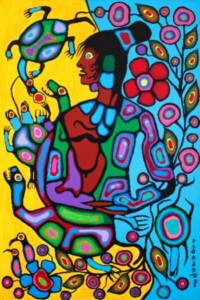New art exhibit paints relationship between First Nations and government

By Kristin Grant
TORONTO—Tucked away on Toronto’s CNE grounds, a new exhibit “Looking Forward, Looking Back: A Visual Exploration of Canada’s Relationship with its Indigenous Peoples” at the Withrow Comon Gallery is worth the trek. As the title suggests, the exhibition is in two parts. The Looking Back part examines each of our 29 Prime Ministers and provides a snap shot into relations between the government and First Nations during their time in office. The Looking Forward part features artwork by First Nations artists with a theme of looking ahead and the future relationship between the two groups.
If one wants to understand how the present relationship between First Nations and the Government came to be, look no further than this exhibit. It is easy to be overcome by the raw racism emanating from some of those previously in charge of Indian Affairs.
There are large quotations along the walls, which exhibit curator Andrea Jackman explains, “the quote bubbles are a way of acknowledging that the didactics on the wall are very long and wordy. Thus, one would be able to simply read the quote bubbles and get a rough idea of the position of the Canadian government during that time period.”
A prime example is the quote from 1920 by Deputy Superintendent of the Department of Indian Affairs Duncan Campbell Scott, “our object is to continue until there is not a single Indian in Canada that has not been absorbed into the body politic, and there is no Indian question, and no Indian Department, that is the whole object of the Bill.”
Visitors can see the shift from Minister of the Interior Clifford Sifton 1901’s viewpoint, “to bring the Indians into a state of civilization or comparative civilization, so that they may not be a menace to the Country.”
By 1998, Indian Affairs Minister Jane Stewart has a much different view, “as a country, we are burdened by past actions that resulted in weakening the identity of Aboriginal peoples, suppressing their languages and cultures and outlawing spiritual practices.”
The second half of the exhibit Looking Forward focuses on First Nations voices in the form of artwork from the community. It included artists Carl Beam, Shirley Cheechoo, Irene Avaalaaquiaq Tiktaalaaq, Christian Morrisseau (son of famed Woodlands style artist Norval Morriseau), Cecil Youngfox and Kris Nahrgang.
“The artists selected to be juxtaposed with the exhibition are well established indigenous artists who have made great waves to bring Indigenous culture, ideas, stories and voice to the forefront,” explains Jackman.
A 28-foot unity pole by Kawartha Nishnawbe First Nation Chief, artist, TV host and archaeologist Kris Nahrgang is the final piece of the exhibit. Originally commissioned for the CNE as part of Canada 150, Nahrgang says the pole started “as an art project and turned into a message of unity.” He felt quite honoured to be asked despite being conflicted about Canada 150.
On how this work fits into the exhibit he says, “when I look at the comments from the Prime Ministers, some of them were trying to move forward, but it was a genocide…The government had a 100-year plan…lucky for our people, we are resilient. Our communities are thriving.” Nahrgang thinks, “after the comments, the unity pole is the flip side of the coin, no one has looked at before.”
Visitors have the opportunity to watch a video showing the elaborate process of building the pole from selecting the cedar tree to the unveiling at the CNE and everything in between. It is fascinating to watch Nahrgang—who normally is a soapstone carver—bring the shapes to life whether it is a sacred symbol like the Medicine Wheel or an Eagle Feather, or animals like the turtle, bear, otter and eagle. After the completion, it was nerve-wracking watching footage of the pole making the trip down the 401—one of North America’s busiest highways—on the back of a flatbed truck to its new home.
Nahrgang finds he has had more interest in the pole from places like Mexico and Germany than from Canada.
Case in point, personally, I didn’t even know about the unity pole until this exhibit. Eventually the pole will find a permanent home on the CNE grounds. There appears to be some feet dragging on their part in actually choosing a location, and then there needs to be an archaeological survey before groundbreaking. Once permanently homed, the pole will serve as a reminder of what we should be working towards.
“One of the reasons the unity pole came to be is inclusiveness. We need to start somewhere,” Nahrgang states. He believes that “unity is the only way to move forward in this beautiful country”.
Until the pole finds its new home, it will be on display at the as part of the “Looking Forward, Looking Back: A Visual Exploration of Canada’s Relationship with its Indigenous Peoples” exhibit until April 7. It is an eye-opening exhibit for both First Nations and non-First Nations alike.
The Withrow Common Gallery is open Thursdays 6pm to 9pm and Saturday 1pm to 5pm. Admission is free.


